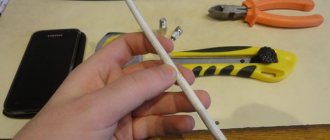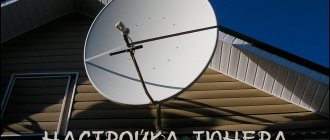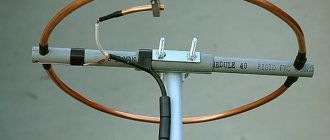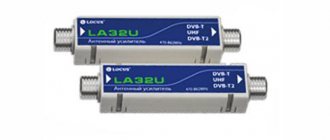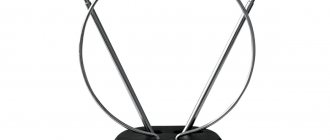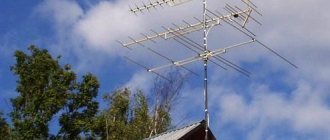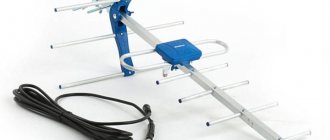A satellite antenna is usually purchased as a ready-made solution kit for a specific satellite television service operator. But when the need arises to independently choose a device for receiving television programs, the consumer is faced not only with a grid of deflector diameters, but also with many other characteristics of a particular product. Different types of satellite dishes may look the same, but have their own operating characteristics and, of course, different price tags. In fact, choosing the optimal model is not difficult. The main thing is to know the key features of individual classes of devices for receiving high-frequency radio signals.
What types of satellite dishes are there?
Since the discovery of satellite communications, many types of wave receivers have been created for receiving and transmitting signals. Each type has found its own ground application depending on the purpose of the satellite communication system:
- mobile connection;
- satellite telephony and radio broadcasting;
- navigation via orbital communications;
- Internet;
- meteorology;
- communication with spacecraft;
- TV.
Ordinary TV viewers are more familiar with mirror-type (offset) devices. The most famous family of satellite dishes, which is presented in stores. They differ in the shape of the reflector, are different in diameter, have different surface utilization rates and are accepted in different ranges.
Offset
Offset satellite dish
This satellite TV antenna has a reflective bowl in the shape of an ellipsoid. Radio waves from satellites that bounce off the working mirror are concentrated not in the geometric center of the figure, but in its lower focus. A bottom focus dish does not require a large elevation angle. This design of the mirror in offset satellite antennas made it possible to achieve more stable reception, because The signal converter does not cast a shadow on the surface of the bowl and does not cause noise.
Direct focus
direct focus satellite dish
This type of wave receiver has a working mirror surface in the shape of an oblate paraboloid. This symmetrical reflector geometry makes it possible to achieve good capture of radio waves arriving at its surface and maximum redirection of them to the converter. It is mounted on holder consoles directly above the central point of the plate.
Toroidal
Toroidal satellite dish
A toroidal dish, a type of multibeam antenna, is a progressive solution that replaced mirrors on rotating mechanisms. Figuratively speaking, this is not just a “plate”, but a whole service, consisting of a large dish, a saucer and several converter cups. This model has two reflectors (reflectors) and this is a huge advantage for receiving TV from different satellites. Before radio waves hit the receiving surface of the converting head, they will be reflected twice: first hitting a large mirror, and then refracting from it to a small one, where they are focused on the desired converter.
Manufacturers of toroidal antennas guarantee that they are equipped with up to sixteen converters. This opens up very great opportunities for the viewer: redirecting such a device to work with signals from different satellites can now be done without getting up from your chair in front of the TV.
PAR
Phased antenna
Phased array antennas are actually a rarely used class of satellite equipment. They were popular in the 90s of the last century, which they owe to Nokia. Having a list of limitations, narrowband, labor-intensive production, and hence high cost, phased arrays are not actively used by consumers of television equipment.
Based on the use of controlled phased arrays, the development of mobile and portable satellite communication receivers is being carried out.
Traveling wave antennas
Directional antenna
This is a directional type receiver. The signal in it propagates in the form of a traveling wave along the geometric axis of the structure. In terms of its structure, it is a collecting line on which several vibrators equidistant from each other are attached. This antenna is broadband (VHF and UHF waves) and does not require adjustment. Common among meteorologists and in amateur radio communications.
Weakly directional antennas
Weakly directional wave antenna
Weakly directional wave receivers have found their application in those places of satellite reception where it is not possible to constantly redirect the position of the receiving device. The antenna produces a lot of noise due to its wide radiation pattern. But this is not critical for capturing relayed waves from low-orbit satellites.
For a private home
Although private houses come in different sizes, the average house occupies about 100 square meters. Based on this, we can assume that there will be at least two TVs in the house.
Providers have the following kits for two modern TVs:
- Tricolor TV FULL HD set for 2 TVs. It includes a Twin converter, two receivers, GSE501 and GS C591, connected to each other (wired or via Wi-Fi). Using the kit you can watch high definition channels. The range of TV channels is huge, suitable for people of any category. Price: 10,500 rubles.
- NTV Plus set for 2 TVs. With it you can watch TV on two devices independently of each other. A converter with two outputs is connected to the satellite dish and two cables go from the antenna to the receivers. Each TV has its own NTV-PLUS710HD set-top box. You can watch SD and HDTV channels. Price 13,700 rubles.
- MTS also includes 2 independent cables for EKT DSD 4614i set-top boxes for 2 TVs. There are few UHD channels, but HD is shown well. There are discounts and promotions for the first connections to packages. Price 11850 rubles.
For the dacha
Choosing a satellite dish for your dacha is not difficult. The house usually has one TV, and not the latest model. Therefore, to connect, a very ordinary set with a receiver that produces SD and HD quality TV channels is enough.
- An inexpensive set of satellite Tricolor TV with a DTS 54 prefix. You can connect both an old and a new TV. 4K viewing is not implemented. An excellent option for rural areas. Price 7500 rubles.
- An inexpensive NTV set with an NTV-PLUS 710HD receiver allows you to connect and watch a lot of TV channels, including the “Sports”, “Premiere Movies”, “Popular Science” and others packages. Price 8990 rubles.
- MTS TV “standard” with the EKT DSD 4614i set-top box even works with UHD TV. There are options for recording TV programs onto a flash drive or external drive. Implemented support for H.265/AVC. An excellent price for the village - 7,000 rubles.
To the apartment
Which satellite dish to choose for an apartment is of interest to many residents of large cities. Usually, they settle on a satellite dish for one TV. If you need to connect two TVs, pay attention to “for home” kits. For an apartment, we will consider satellite TV with receivers that can record programs.
- The Tricolor TV set with GS E502 is equipped with a 500 GB hard drive. Using the drive, you can easily record programs. In addition, the Timeshift option is implemented - rewind or pause a TV show. Price 11,730 rubles.
- NTV Plus has a similar set with recording capabilities. It comes with a Thomson DSI 8020 HDTV receiver for recording shows and movies. Recording can be done using a timer. The size of the built-in hard drive is 500 GB. Price: 10,490 rubles.
- MTS Premium does not have a built-in hard drive, but the Openbox AS1 receiver that is present runs on Android. Because of this set-top box, all sorts of options are available, including access to film libraries and IPTV, viewing from connected media and recording television content on them. Price: 13140 rubles.
In general, you can select and configure the kit yourself.
Useful: How to install a satellite dish yourself
Types of satellite dishes
Satellite television antennas come in different types, sizes, and are created using several types of reflection.
Round
Round satellite antennas for TV are considered classics. This is the optimal shape for receiving a good signal from a distant radiation source. Round plates are available in a variety of sizes, with several types of stands and support rods. The surface of such a product is solid and smooth.
Multifocal
Multifocal antennas perform the task of receiving signals from several satellites at once. A group of converters is installed in them. The calculation of a multifocal antenna is always individual. This can be a classic main deflector and a group of resonant reflectors. A multifocal satellite antenna is quite capable of being a toroid with waveguide leads.
Important! In domestic conditions, it makes no sense to use such a design. Multifocus systems cannot work with weak satellite signals
To ensure a sufficient level of electrical energy at the output, the antenna will have to be made unacceptably bulky.
Mesh
These satellite dishes are like a curved picnic grill with a support post attached and a converter screwed to it. Such systems operate on two principles at once. They reflect the signal and simultaneously generate it due to the occurrence of resonant phenomena.
Most often, indoor satellite antennas for TVs have this design. Thanks to the mesh deflector, they weigh little. And its special shape ensures clear directionality of the antenna.
Important! The mesh design has a key disadvantage - it is not able to work in regions with unstable coverage. The antenna requires optimal radiation flux characteristics. But in practice, mesh systems (also called perforated) are very common
These are transceiver satellite antennas that take full advantage of the phenomenon of wave resonance. Compact solutions for extending Wi-Fi signal transmission are popular. There are also very common systems consisting of small mobile mesh antennas on the subscriber side and ground stations for transmitting the signal. This is the well-known T2 broadcast format
But in practice, mesh systems (also called perforated) are very common. These are transceiver satellite antennas that take full advantage of the phenomenon of wave resonance. Compact solutions for extending Wi-Fi signal transmission are popular. There are also very common systems consisting of small mobile mesh antennas on the subscriber side and ground stations for transmitting the signal. This is the well-known T2 broadcast format.
Active Electronically Scanned Array (AESA)
Outside, AFAR (AESA) and PFAR (PESA) are difficult to distinguish, but inside they are radically different. PFAR uses one or two high-power amplifiers to transmit a single signal, which is then divided into thousands of paths for thousands of phase shifters and elements. An AFAR radar consists of thousands of reception/transmission modules. Since the transmitters are located directly in the elements themselves, it does not have a separate receiver and transmitter. The differences in architecture are shown in the picture.
In AFAR, most of the components, such as a weak signal amplifier, a high-power amplifier, a duplexer, and a phase shifter, are reduced in size and assembled in one housing called a transmit/receive module. Each of the modules is a small radar. Their architecture is as follows:
Although AESA and PESA use wave interference to shape and deflect the beam, the unique design of AESA provides many advantages over PFAR. For example, a small signal amplifier is located close to the receiver, before the components where part of the signal is lost, so it has a better signal-to-noise ratio than a PFAR.
Secondly, with a conventional radar, the ability to reduce spurious interference is limited by hardware instability errors. The biggest contributors to these errors are the analog-to-digital converter, downconverter, high-power amplifiers, small-signal amplifiers, and wave generator. With an AFAR with a distributed group of high-power amplifiers and weak-signal amplifiers, such errors can be reduced. As a result, AFAR sensitivity increases in noisy conditions.
Moreover, with equal detection capabilities, AFAR has a lower duty cycle and peak power. Also, since individual APAA modules do not rely on a single amplifier, they can transmit signals at different frequencies simultaneously. As a result, AFAR can create several separate beams, dividing the array into subarrays. The ability to operate on multiple frequencies brings multitasking and the ability to deploy electronic jamming systems anywhere in relation to the radar. But forming too many simultaneous beams reduces the radar's range.
The two main disadvantages of AFAR are high cost and limited field of view to 60 degrees.
Hybrid electronic-mechanical phased array antennas
The very high scanning speed of the phased array is combined with a limited field of view. To solve this problem, modern radars place phased arrays on a movable disk, which increases the field of view. Do not confuse the field of view with the width of the beam. Beam width refers to the radar beam, and field of view refers to the overall size of the area being scanned. Narrow beams are often needed to improve accuracy and range, but a narrow field of view is usually not necessary.
Why size matters
The key to trouble-free TV reception from satellite is the purchase of high-quality equipment, its correct installation and selection of the optimal size of the dish itself. It is with this last point that troubles often arise. Some TV viewers are so concerned about aesthetics that they immediately reject the decision to buy a large antenna, but often the diameter of the antenna is the determining criterion in areas with problematic signal reception. The larger the antenna, the better it captures the signal, for example in case of bad weather. A dish with a diameter of 60 cm, although it looks compact, does not guarantee the absence of signal interruptions. The optimal solution for stable reception of channels from a satellite, if you have space, is to install a satellite dish with a diameter of 80-90 cm.
| Comparative characteristics of antennas with large and small diameters | |
| Small diameter | Large diameter |
| It is lightweight and easier to attach, for example, to balcony railings | its installation is complicated by significant weight |
| no need for reinforced holders | takes up more space |
| does not hide illumination | installed on a balcony, can block natural light |
| it is more difficult for it to catch a signal, but it is unlikely to catch interference from adjacent satellites | picks up satellite signals more easily, but may pick up interference from nearby satellites |
| more susceptible to weather conditions (clouds, snow and rain) | less susceptible to weather conditions |
Here are some recommendations for antenna sizes:
- stationary antenna for receiving channels from one satellite – diameter from 55 cm to 80 cm;
- antenna with one or more converters for receiving signals from several satellites - diameter from 80 cm to 105 cm or more. It all depends on how many converters you plan to install (one converter – one satellite). If there are more than two, it is better to buy an antenna with a diameter of 90 cm;
- rotating plate - diameter ranges from 80 cm to 140 cm. The rotating mechanism is not a popular option.
How does a satellite dish work?
A satellite television antenna is used to receive a television signal from a space satellite. The parameters of the dish itself and its converter largely determine the quality of image and sound that the satellite decoder will give you on your TV screen. Let's consider the principle of their operation.
Satellite dish operation
The signal level received from a satellite on earth is very small compared to its original level: attenuation is about 200 dB. This is understandable: the distance that separates the earth from the satellite is about 36,000 km. You can only receive a signal strong enough to watch programs if you concentrate it as much as possible. It is this function that is performed by the satellite wave receiver, which is a curved surface, colloquially called a dish.
The waves sent by the satellite to the earth are reflected by the inner surface of the antenna, obeying the laws of optics, and are concentrated at a point called the focus. At this point the receiving head of the transducer is located, a device for converting high-frequency vibrations into a cable signal.
Two-dimensional antenna array
Multi-element array of dipoles used in the HF bands (1.6 - 30 MHz), consisting of rows and columns of dipoles. The number of rows can be 1, 2, 3, 4 or 6. The number of columns can be 2 or 4. The dipoles are horizontally polarized and a reflective screen is placed behind the dipole array to provide an amplified beam. The number of dipole columns determines the width of the azimuthal beam. For 2 columns the beam width is about 50°, for 4 columns it is 30°. The main beam can be tilted 15° or 30° for maximum coverage of 90°.
The number of rows and the height of the lowest element above the ground determines the elevation angle and the size of the serviced area. An array of two rows has an angle of 20°, and an array of four has an angle of 10°. The radiation from a two-dimensional array usually approaches the ionosphere at a slight angle, and due to its low frequency, is often reflected back to the earth's surface. Since radiation can be reflected many times between the ionosphere and the ground, the antenna's action is not limited to the horizon. As a result, such an antenna is often used for long-distance communications.
Directional pattern
Advantages and disadvantages
If we compare the two most popular types of television satellite receivers - with direct focus and with shifted focus - the picture will be as follows.
Direct focus paraboloid mirrors are available with a larger circumference to reduce transducer interference. These antennas will be useful for those who need a strong signal, and they are also characterized by broadband. But their main disadvantage lies in the complexity of installation, which is made difficult by the bulkiness of the plate and the requirements for its placement. In a direct-focus dish, precipitation will inevitably settle and accumulate, because it “looks” at the sky line at an obtuse angle. They cover the reflective surface, blocking the signal, and cause corrosion, which has a detrimental effect on the working surface. During snowy winters, you will have to clean the antenna bowl frequently.
Offset plates have a number of advantages:
- they are more compact, but this has little effect on the signal quality;
- they are easier to install;
- the position of their fixation prevents the accumulation of sediments;
- have the ability to connect an additional converter.
A slight inconvenience is the periodic cleaning of the offset plate converter from frozen sediments, because... its receiving surface faces the sky. This may make the device difficult to operate in winter.
Antennas for satellite television
Toroidal antenna
The technical design features of such antennas make it possible to receive signals from 16 satellites simultaneously within a range of 55 degrees. In this case, each converter is located directly at the focus of the satellite to which it is directed. Reliable and high-quality signal reception is ensured by the use of a toroidal reception formula when designing an antenna - the use of two reflectors (mirrors). The signal from the main reflector is reflected onto the additional reflector, after which it enters directly into the converter feed. The presence of two mirrors and a careful approach to the design of reflective surfaces are the main advantages of a toroidal antenna over an offset one. Using these devices, the user can build a multi-system without the use of rotating devices. This way you can get rid of a number of shortcomings, such as:
- slow switching between channels broadcast from different satellites;
- the impact of adverse weather conditions on the performance of the drive.
A toroidal antenna is the best option because... makes it possible to install a different number of converters. Thanks to this, the speed of switching channels from one satellite is no different from the speed of switching channels on different satellites.
Parabolic antenna
People often mistakenly call any satellite dish “parabolic”. In fact, not all satellite dishes are parabolic.
Satellite equipment is equipment that receives a signal from a satellite. Parabolic antennas are the most common type of satellite antennas. They are used to receive radio broadcasts, television and provide Internet access. All such antennas are divided into two types: direct focus and offset antennas.
Active or passive
An active antenna is one that has an amplifier built into its housing. The amplifier must be connected to passive antennas separately.
Active antennas can be cheaper and still be able to receive more channels. But at the same time, they have one very serious drawback: the amplifier board is very “delicate” and easily fails in any serious bad weather, for example, during a thunderstorm. We have to replace the board. To do this, you need to remove the antenna, remove the board, and install a new one. And such a procedure may be required after each thunderstorm.
But even if thunderstorms do not affect the quality of the antenna in any way, after a few years the number of channels with an impeccable image will begin to decline. The quality will get progressively worse until it becomes completely bad. This usually occurs due to oxidation of contacts and elements on the board. Receivers on the antenna are not sealed, so everything inside inevitably gradually becomes damp, dust accumulates, and debris and insects can get in. Therefore, most often the service life of such devices does not exceed 1-2 years.
To increase service life, it is recommended to protect all antenna elements from harmful environmental influences immediately after installation. For this, silicone, plastic bottles cut into pieces, or simple plastic film secured with tape are used. Moreover, it is necessary to close all contact points, including the cable connection point.
Passive antennas differ favorably from active ones in that only the receiving iron structure itself is installed outdoors, and the amplifier can be located either in the attic or directly in the house. Such antennas pick up fewer channels, but the image quality is better and they last longer. Such antennas have one more advantage: some amplifier models have 2 adjustment options - separately for each wave range
This is an important property, because sometimes some channels come with a higher level and suppress weaker ones
Then there is an overlap of sound and image. In some cases, with a very strong signal, there may be only “snow” on the screen. To correct the situation, you need to adjust the sensitivity of the ranges. Therefore, passive antennas with separate amplifiers are most often purchased for dachas.
Samsung and LG TVs have a “weak signal” function. In these cases, an antenna amplifier may not be needed. Such TVs, using a passive antenna, should receive at least 5-6 channels well.
Cassegrain antenna with flat phase plate
Another design designed to combat beam blocking by an auxiliary reflector is the flat plate Cassegrain antenna. It works taking into account the polarization of waves. An electromagnetic wave has 2 components, magnetic and electric, which are always perpendicular to each other and the direction of movement. The polarization of the wave is determined by the orientation of the electric field, it can be linear (vertical/horizontal) or circular (circular or elliptical, twisted clockwise or counterclockwise). The interesting thing about polarization is the polarizer, or the process of filtering the waves, leaving only waves polarized in one direction or plane. Typically, the polarizer is made of a material with a parallel arrangement of atoms, or it can be a lattice of parallel wires, the distance between which is less than the wavelength. It is often assumed that the distance should be approximately half the wavelength.
A common misconception is that the electromagnetic wave and polarizer work in a similar way to an oscillating cable and a plank fence - that is, for example, a horizontally polarized wave must be blocked by a screen with vertical slits.
In fact, electromagnetic waves behave differently than mechanical waves. A lattice of parallel horizontal wires completely blocks and reflects a horizontally polarized radio wave and transmits a vertically polarized one - and vice versa. The reason is this: when an electric field, or wave, is parallel to a wire, it excites electrons along the length of the wire, and since the length of the wire is many times greater than its thickness, the electrons can easily move and absorb most of the energy of the wave. The movement of electrons will lead to the appearance of a current, and the current will create its own waves. These waves will cancel out the transmission waves and behave like reflected waves. On the other hand, when the electric field of the wave is perpendicular to the wires, it will excite electrons across the width of the wire. Since the electrons will not be able to actively move in this way, very little energy will be reflected.
It is important to note that although in most illustrations radio waves have only 1 magnetic field and 1 electric field, this does not mean that they oscillate strictly in the same plane. In fact, one can imagine that electric and magnetic fields consist of several subfields that add up vectorially. For example, for a vertically polarized wave from two subfields, the result of adding their vectors is vertical. When two subfields are in phase, the resulting electric field will always be stationary in the same plane. But if one of the subfields is slower than the other, then the resulting field will begin to rotate around the direction the wave is moving (this is often called elliptical polarization). If one subfield is slower than the others by exactly a quarter of a wavelength (the phase differs by 90 degrees), then we get circular polarization:
To convert linear polarization of a wave into circular polarization and back, it is necessary to slow down one of the subfields relative to the others by exactly a quarter of the wavelength. For this, a grating (quarter-wave phase plate) of parallel wires with a distance between them of 1/4 wavelength, located at an angle of 45 degrees to the horizontal, is most often used. For a wave passing through the device, linear polarization turns into circular, and circular into linear.
A Cassegrain antenna with a flat phase plate operating on this principle consists of two reflectors of equal size. The auxiliary reflects only horizontally polarized waves and transmits vertically polarized waves. The main one reflects all waves. The auxiliary reflector plate is located in front of the main one. It consists of two parts - a plate with slits running at an angle of 45°, and a plate with horizontal slits less than 1/4 wavelength wide.
Let's say the feed transmits a wave with circular polarization counterclockwise. The wave passes through the quarter-wave plate and becomes a horizontally polarized wave. It is reflected from horizontal wires. It passes through the quarter-wave plate again, on the other side, and for it the plate wires are already oriented mirror-image, that is, as if rotated by 90°. The previous change in polarization is reversed, so that the wave again becomes circularly polarized counterclockwise and travels back to the main reflector. The reflector changes polarization from counterclockwise to clockwise. It passes through the horizontal slits of the auxiliary reflector without resistance and leaves in the direction of the targets, vertically polarized. In receive mode, the opposite happens.
How to choose the right satellite dish size
Satellite antenna sizes may vary. Broadcasting providers try to offer subscribers the same reception conditions. Some, like MTS, offer different antenna units in different regions. Others, for example, Telecard, provide all the necessary data for the subscriber to independently select a model. Their official websites usually have a table indicating what diameter of the deflector is recommended to be installed in a particular broadcast region.
Based on the principle of operation of the system, it is clear what role the dimensions of satellite antennas play. The larger the reflective surface of the deflector, the more wave energy it collects and directs to the converter.
Satellite broadcast networks are always calculated using average normalized parameters. Thus, in an area of optimal reception, a subscriber can install a standard dish with a diameter of 60 cm. In areas with low signal levels, it is rational to choose a deflector of 90 cm or larger. You need to rely on the provider's recommendations. But you shouldn't follow them completely. Calculation of the optimal antenna dimensions is made based on the following assumptions:
- the subscriber has a correctly installed and configured antenna;
- the focusing axis of the deflector completely coincides with the direction towards the satellite;
- The surface of the plate is always clean and smooth and has nominal parameters.
In practice, this is not the case. There are trees and clouds in the signal path. The weather outside may be bad. The plate collects dirt that falls with precipitation and is carried by the wind. All this worsens the quality of reception.
Advice! The rule for choosing an antenna based on the diameter of the deflector is quite simple: it is better to buy a product with the following grid size. For example, with the provider's recommendations of 90 cm, an installed dish of 1.2 m will provide good reception under any conditions.
Conclusion
When deciding which satellite antenna is better, give preference to the toroidal model if you need to ensure reception from several providers. On the contrary, if there is no choice, there is no need to complicate the equipment.
Important to know: larger plate size, higher gain:
- more difficult to point at a satellite;
- more interference in windy weather.
A light breeze shakes the house, it cannot be noticed with the naked eye, when it comes to catching a small celestial point, the movement will become unacceptable in magnitude. The fact will be felt by those living in open areas where storms or storms often occur.
General characteristics of satellite antennas
When choosing a satellite dish, you need to consider the following parameters:
- The diameter of the equipment plays a significant role. If you are not sure of the high signal level of the satellite at your place of residence, then it is better to choose a dish with a large diameter.
- Satellite shape: direct focus and offset antenna.
- direct focus are classic round plates with an attached convector in the center. Fixation is performed with two or three spokes, which tend to partially create a shadow on the reflective coating of the satellite. This feature helps to reduce the utilization rate of the equipment surface, but this defect will manifest itself less on large-diameter plates. The signal quality on the direct focus model may decrease in winter due to the accumulation of snow and ice on the surface of the dish;
- As for the offset shape of the satellite, it is installed in an almost vertical position, which prevents the accumulation of liquid and snow. In addition, the convector is not located in the center, but closer to the bottom. This feature allows you to avoid obscuring the satellite.
- Before purchasing, you should carefully inspect the equipment for defects.
- What material is satellite equipment made of? For example, a steel antenna is more durable and affordable, but it is heavy and can be damaged by corrosion over time. If you choose such a model, then you need to focus on the quality of coloring. But a plastic satellite is lightweight, but in winter a lot of snow will accumulate on it, which can lead to rapid deformation.
- Suspension elements, brackets, and fasteners must be of high quality, reliable, and resistant to external conditions and strong winds.
Not every average person will be able to competently understand the intricacies of satellite antennas, so before purchasing, it is better to tell experienced specialists about your wishes, who will help you choose the most suitable satellite antenna model. High-quality satellites have advanced functionality, allowing you to watch over 500 channels, access the Internet, and set restrictions for children in the form of blocking programs for adults.
Selecting a satellite dish
Before buying an antenna for watching satellite television, it is recommended to study all the offers in stores. To install a good antenna in a village, you need to clearly understand all the features of broadcasting specifically in your region or area.
Currently, the most popular antennas on the Russian market are Supral, Corab, Lans, Skymax, and Azure. Antennas from Chinese manufacturers are also in demand.
"Azure AS-35T"
Easy to install device. Can even be mounted on the roof of a car. Small size, light weight, ease of operation, reliable design - all this makes this model very attractive. Can be connected to a laptop with a DVB-S/S2 satellite USB drive.
Disadvantage of the model: possible slowdown of the gain.
"Supral-0.9 m"
It is considered one of the most reliable. Receives signals from “Rainbow-TB”, “Telecards”, “Sirius”, “Hotbird”. Large dimensions and heavy weight provide the device with good wind resistance. One of the important advantages is the high gain. With such characteristics, the cost of the model is considered quite acceptable.
The main disadvantage is that the plate becomes corroded over time.
"Lans-65"
It is considered a very stylish design. Despite the high cost, this model is recognized as the best offset plate with a diameter of 65 cm.
Main advantages of the model:
- presence of self-cleaning function;
- assembly reliability;
- interesting design;
- high signal quality;
- ease of installation.
The main disadvantage is the small diameter of the plate.
Reviews of satellite dishes
Elena. I have Tricolor TV at my dacha. I come to live at the dacha for 3 months in the summer. Every year, before launch, the receiver downloaded and updated itself, and after that it just started showing TV. For the fourth summer after installing the Tricolor satellite kit, the update stopped downloading and no longer shows TV. The operator's support made it clear that the receiver was out of date and needed to be replaced with a new one. And this costs a pretty penny. At the same time, the satellite dish did not even show rust anywhere.
Vladimir . I installed a satellite dish from MTS Plus. I ran into a problem that as soon as even the slightest rain starts, the channel just freezes and doesn’t show anything else. The problem is solved by switching to another channel and back. What this is connected with is not entirely clear.
Paul . For 25 HD and more than 200 channels, the annual subscription fee of 1200 rubles suits me quite well. I paid for the kit once and have been using it for three years now. Yes, there are disadvantages of satellite television in rain or fog, but these are rare. Basically the TV is excellent. I am happy with everything.
Material of manufacture
What a satellite dish consists of, namely the construction material, essentially has no effect on the quality of the received signal. The main thing is that it fulfills its reflective function. But there is another important criterion: satellite dishes are always installed outdoors, which means they must be resistant to various external factors.
The coating of the dish is designed to effectively protect it from corrosion, and in this regard, antennas made of aluminum have proven themselves well; they make up the majority of manufactured models. But they have one minor and completely removable drawback - a certain softness. A gust of strong wind can tear the antenna bowl off its mounts: the screws that come with the fasteners can be torn out through the soft metal and your satellite dish may well become “flying.” From the outside it may look comical (a UFO is flying), but in reality it is dangerous, because the device is installed at a height and it is unknown where it will land.
Despite this, we recommend aluminum plates, but with rigid mounting. You can strengthen the mount yourself by using stronger screws and larger washers. A satellite dish made of aluminum, even after several years, will look like new, but will cost you more.
A more economical option is a steel antenna. There is no doubt about its strength; its service life is more than 10 years. If this seems not enough to you, then do not forget that progress is unstoppable, and during this time technology will definitely step forward, as is the case with information compression. But when buying a steel plate, inquire about its protective coating; if it is of poor quality, it may rust.
Plastic satellite dish
Plastic dishes with metal coating are an innovation in the satellite TV equipment market. The ubiquitous plastic has penetrated here too. Whether this is good or bad, time will tell. According to some observations, the price of these antennas is quite high, and the performance is worse than that of aluminum dishes; there is no need to talk about durability. So nothing interesting, except for easy installation.
In areas where frequent and strong winds blow, where installation is carried out at high altitudes, a perforated metal antenna is recommended. The “sieve” effect helps reduce the windage of the antenna.
What kind of TV do we watch?
What types of satellite dishes are there? They are divided into several different types depending on the type of signal. Before choosing a satellite dish, let's figure out what kind of television we watch.
Terrestrial analogue television
The signal is encoded and transmitted in one specific wave range - decimeter (UHF) or meter (MB). Over-the-air antennas are most often installed in dachas. They do not always work efficiently, but they are also inexpensive. If you have an ordinary “Soviet” dacha, which you use only during the season, then you spend most of your time on the site. Watch TV either only in the evening or in bad weather. There is no point in installing expensive equipment for several hours of viewing.
Digital television
If somewhere near your home there is a tower that transmits a signal in digital format, then you will be able to receive up to 20 channels in good quality. To do this, you will need a regular UHF terrestrial antenna and a television set-top box that supports the DVB-T2 standard. If you have a modern TV model that supports this standard, then you won’t need a set-top box, you just need to install and configure the antenna correctly.
What specific type of antenna and what model to choose depends on a number of factors and conditions
When choosing, you need to take into account the following criteria:
- location of the house - on a plain, on a hill, in a lowland;
- the presence of tall trees, buildings, structures or objects nearby;
- distance to the nearest tower.
The main importance is given to the distance and possible height of the antenna installation. Sometimes every meter matters.
Antenna installation nuances
Most buyers prefer not to bother and entrust the installation and configuration of the satellite dish to specialists. This is a guarantee that everything will be done quickly and correctly. If you have time, certain skills and the desire to work with your hands, and even save a little, then you can install the satellite dish yourself. In general terms, the installation principle looks like this:
- understand which side the dish will be on and which satellite it will be tuned to. There are many satellites around the Earth, their positions are precisely known and do not change. There are services on the Internet that display which satellites are hovering over a specific area. At the end of the name, as a rule, there is something like 36E or 9W - this is the longitude above which the satellite is located. Choose a place where there is no shadow or other interference. There are special programs that will help calculate the antenna tilt angle depending on the coordinates of the area and the selected satellite. You can use the compass and azimuth information for a specific satellite. On the ground, all that remains is to determine the north, find the given azimuth and point the dish in the desired direction;
- Before fixing the antenna, it is better to check the presence of a signal;
- First, the bracket is mounted. To do this, holes are made for anchors on the load-bearing surface using a hammer drill. The size of the latter depends on the weight of the plate and the type of supporting material. If the walls are wooden, then it is important to attach the bracket to a beam or log, but not to the sheathing;
- The plate is mounted on a bracket. An offset antenna can be strictly vertical, but it is better to tilt it back by 1.5-2 cm; for a direct-focus dish, the tilt angle is 20-40 degrees.
Next, it remains to configure the antenna correctly.

